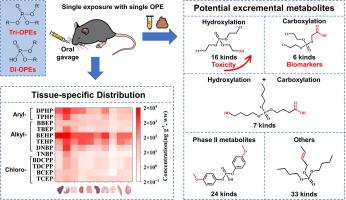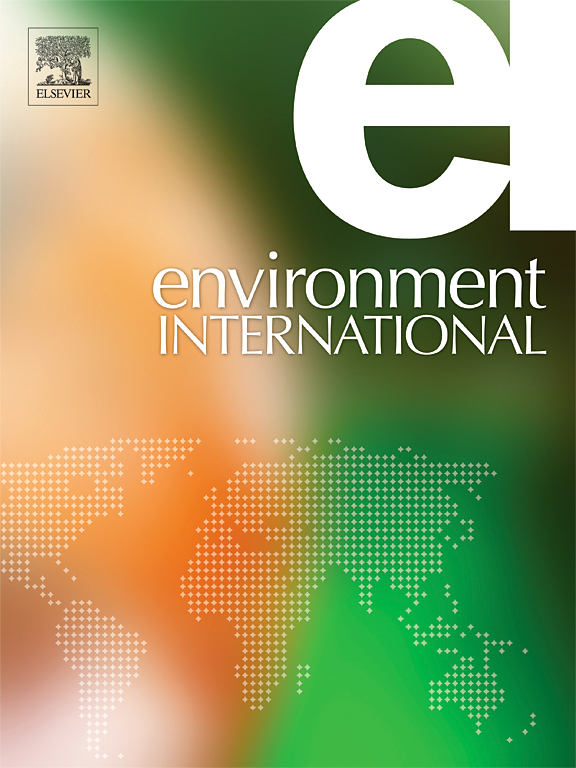A comparative study for organophosphate triesters and diesters in mice via oral gavage exposure: Tissue distribution, excreta elimination, metabolites and toxicity
IF 10.3
1区 环境科学与生态学
Q1 ENVIRONMENTAL SCIENCES
引用次数: 0
Abstract
Organophosphate triesters (tri-OPEs) and diesters (di-OPEs) may threaten human health through dietary intake, whereas little information is available about their fate in mammals. Herein, mice exposure experiments were carried out through gavage with six tri-OPEs and six di-OPEs, respectively. The residual levels of di-OPEs in mice were generally higher than those of tri-OPEs. The residual di-OPEs mainly distributed in the liver and blood while the most tri-OPEs remained in stomach, indicating easier transfer and lower metabolism levels of di-OPEs. The accumulation of tri- and di-OPEs with large octanol–water partition coefficients and long carbon chain were observed in tissues and feces, implying that the elimination of these OPEs through fecal excretion is an important elimination pathway. A total of 86 OPE metabolites were found in murine urine and feces, 57 of which were identified for the first time. For tri-OPEs, carboxylated OPEs had higher peak intensities and fewer interference factors among the metabolites, which could serve as ideal biomarkers. The predicted oral median lethal doses of OPEs and corresponding metabolites showed an increased toxicity of some hydroxylated OPEs and di-OPEs, needing further attention. These results provided new insights and evidence on the fates and biomarkers of OPEs exposure for mammals.


小鼠口服有机磷三酯和二酯的比较研究:组织分布、排泄物消除、代谢物和毒性
有机磷酸酯三酯类(三-OPEs)和二酯类(二-OPEs)可能会通过饮食摄入威胁人类健康,但有关它们在哺乳动物体内转归的信息却很少。在此,我们分别通过灌胃的方式进行了小鼠接触六种三OPE和六种二OPE的实验。小鼠体内二OPE的残留水平普遍高于三OPE。残留的二-OPEs 主要分布在肝脏和血液中,而大部分三-OPEs 残留在胃中,这表明二-OPEs 更容易转移,代谢水平较低。在组织和粪便中观察到辛醇-水分配系数大、碳链长的三-OPE 和二-OPE 累积,这表明通过粪便排泄是消除这些 OPE 的重要途径。在小鼠的尿液和粪便中总共发现了 86 种 OPE 代谢物,其中 57 种是首次发现。就三OPE而言,羧化OPE的峰强度较高,代谢物之间的干扰因素较少,可作为理想的生物标记物。OPE和相应代谢物的预测口服中位致死剂量显示,一些羟基化OPE和二OPE的毒性增加,需要进一步关注。这些结果为哺乳动物接触 OPEs 的命运和生物标志物提供了新的见解和证据。
本文章由计算机程序翻译,如有差异,请以英文原文为准。
求助全文
约1分钟内获得全文
求助全文
来源期刊

Environment International
环境科学-环境科学
CiteScore
21.90
自引率
3.40%
发文量
734
审稿时长
2.8 months
期刊介绍:
Environmental Health publishes manuscripts focusing on critical aspects of environmental and occupational medicine, including studies in toxicology and epidemiology, to illuminate the human health implications of exposure to environmental hazards. The journal adopts an open-access model and practices open peer review.
It caters to scientists and practitioners across all environmental science domains, directly or indirectly impacting human health and well-being. With a commitment to enhancing the prevention of environmentally-related health risks, Environmental Health serves as a public health journal for the community and scientists engaged in matters of public health significance concerning the environment.
 求助内容:
求助内容: 应助结果提醒方式:
应助结果提醒方式:


